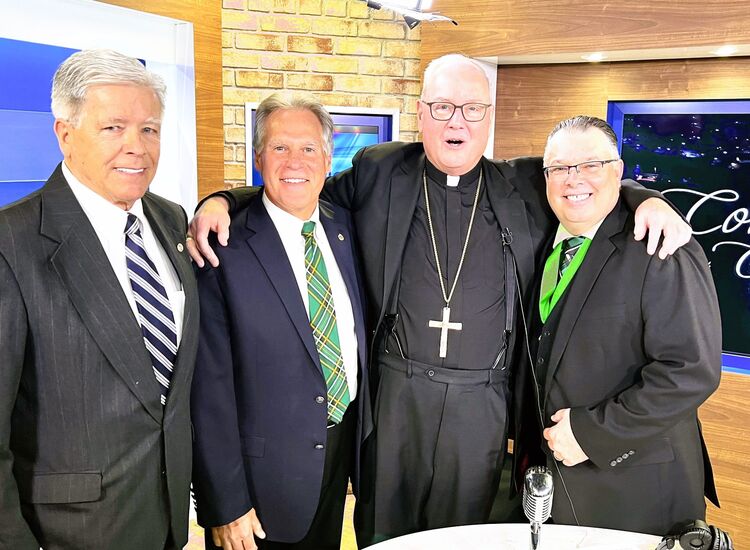[caption id="attachment_67701" align="aligncenter" width="600" caption="Gene Gauntier and Jack Clarke during filming near Killarney in County Kerry a century ago."]
One hundred summers ago, New York's film industry sent a contingent out West and another Eastwards across the Atlantic.
Hollywood in California was desired for its authentic locations by the Biograph Company and its leading director D.W. Griffith. Similarly, a crew from the pioneering Kalem Company, based in Chelsea in Manhattan, set up camp for months in the village of Beaufort, which was close to the world-famous Killarney in County Kerry.
Key members of the group would return for the remaining summers through the First World War, making between 24 and 28 films on themes of rebellion, romance, immigration and assimilation, which helped define Irish America at a crucial moment in its history.
In July, exactly a century after the filmmakers first set up headquarters in Patrick O'Sullivan's family hotel, historian and filmmaker Peter Flynn made the journey to Beaufort to launch "Blazing the Trail: The O'Kalems in Ireland," which examines the first ventures abroad by an American film crew. Included also in his DVD on sale in Ireland are the seven full films that survive and one reel of an 8th.
Meanwhile, the 85-minute "Blazing the Trail" will get its U.S. unveiling at the New York Documentary Festival on next Sunday and again on Tuesday morning.
Flynn's Kerry launch took place in the same family business that hosted the Kalem crews. Padruig O'Sullivan -- a great-grandson of the founder and a great-nephew of Annie O'Sullivan who appeared in many of the films and who passed on to him her memories of those halcyon days - is interviewed on camera.
"We couldn't have made it without him," said Flynn, a Finglas, Dublin, native, who is on the faculty of Emerson College in Massachusetts.
However, the story begins in Cork, where the Kalems, as the company's key members were collectively known, made "The Lad from Old Ireland" in 1910.
It was a big commercial and critical success. A Boston paper said: "The picture is genuine Irish and needs no labeling to prove it. It carries its authenticity on its face."
The trip itself, made just after Hollywood's first movie was released but before a studio was set up there, garnered huge attention generally in America and led to the crew being called the "O'Kalems." The press continued to use that name even in connection with projects that had no Irish connection -- for instance, when reporting on the making of the first life of Christ, "From the Manger to the Cross," which was made in Egypt in 1912.
Back in 1907, the company was successfully sued after it made the first version of "Ben Hur," forcing a codification of copyright laws. (The film's success allowed Kalem to pay the hefty fine imposed.)
Among the Kalem Company's other firsts is the fact that it made the first movies in Ireland and for that reason its remarkable story is known there by experts and academics, and several of them help Flynn tell it. He includes also the small number of U.S. scholars who champion Kalem, a company whose films were viewed by millions each week. More generally, though, the company has been virtually forgotten in this country.
"They're completely ignored in the textbooks on film history; only in the most specialized books do they get mentioned and even then their importance is not stressed," Flynn said. "With the move to Hollywood, those who don't get lost. The Kalems were a victim of that."
Flynn said that the fact that 90 percent of early films have perished has skewed film history. Of those that survived, 75 percent were directed by the prolific Griffith.
Kalem's name was derived from the initials of the last names of the men who founded it: George Kleine, Samuel Long and Frank Marion. The last named ran it but its creative forces were the Canadian-born director Sidney Olcott and the leading lady and scenarist Gene Gauntier.
Olcott, whose mother was reportedly born in the Dublin seaside town of Howth, was increasingly attracted to Irish nationalism, which he was forced by his New York bosses to tone down in the movies after the British authorities complained.
The Kerry-made films more generally buttressed the campaign by upwardly mobile Irish-Americans protesting negative stage stereotypes.
"The underlying meaning [of the films] was that the Irish were noble, the Irish were family-orientated and the Irish had dignity," said Flynn, who came to this country in 1994. "My theory is that the Irish Americans needed to explain why they left to the Americans who looked down their noses at them.
"And a lot of it has to do with nostalgia after you go up through the ranks; you become nostalgic for your working-class roots and your peasant roots," he added.
Not forgetting where you came from was another important theme in works that were partly set in America.
"The films are a psychologically accurate picture of how Irish America viewed itself," Flynn said.
The backdrop to many of the films was the 1798 rebellion and its aftermath, and they typically featured heroic rebels and the priests who helped them get away. In Kerry, the Kalems heard stories that had been handed down through the generations. "They were told as if fresh," Flynn said. "The Kalems lapped them up."
Some of the history was quite recent. Only 20 years before, Charles Stewart Parnell had held one of his last meetings in the field behind O'Sullivan's hotel.
"This is just a few years before the Rising, so they were tapping into something," he added.
Having previously worked on the road in Florida, the crew knew how to ingratiate themselves with locals. In Kerry, they even got the bishop on their side. When Beaufort's priest Fr. Daly complained from the pulpit about love scenes being filmed in front of the graveyard, he was transferred.
Olcott made his last trip as a director in 1914 with his wife, the actress Valentine Grant, to make "Emmett, Ireland's Martyr" (the distributors, it's believed, misspelled the patriot's name). The plan to create a studio in Beaufort, however, was prevented by the outbreak of war in Europe.
In any case, Hollywood flourished under its factory system. Trips abroad were considered too expensive and it was hard to rein in the crews.
Gauntier retired early from the industry. She published her memoirs in 1928 -- "Blazing the Trail" was dedicated to the O'Kalems. The volume was serialized in Women's Home Companion, one of America's most popular magazines.
The Kalem Company went into decline after Olcott broke with it. It was bought by Vitagraph, which in turn was acquired by Warner Brothers.
Olcott drifted out of filmmaking, too, after directing a few Hollywood movies. He kept in regular contact with Beaufort, though, and visited a few more times.
When his wife died in 1949, he sent one of her necklaces to Annie O'Sullivan. But just when it arrived at Christmastime, word came through that the great Kalem director had himself died.
"Blazing the Trail: The O'Kalems in Ireland," written and directed by Peter Flynn and produced by Tony Tracy, will be shown at the IFC Center, 323 Ave. of the Americas (at West 3rd Street), at Sunday, Nov. 6, at 6:20 p.m, and on Tuesday morning, Nov. 8, at 11 a.m. For more details go to nycdoc.net.








